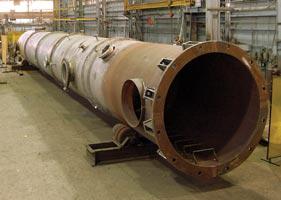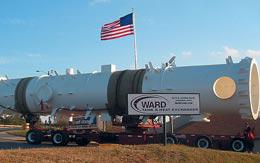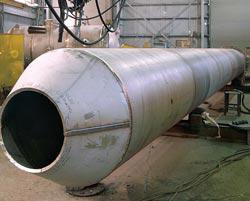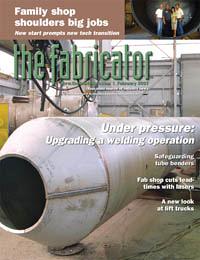- FMA
- The Fabricator
- FABTECH
- Canadian Metalworking
Categories
- Additive Manufacturing
- Aluminum Welding
- Arc Welding
- Assembly and Joining
- Automation and Robotics
- Bending and Forming
- Consumables
- Cutting and Weld Prep
- Electric Vehicles
- En Español
- Finishing
- Hydroforming
- Laser Cutting
- Laser Welding
- Machining
- Manufacturing Software
- Materials Handling
- Metals/Materials
- Oxyfuel Cutting
- Plasma Cutting
- Power Tools
- Punching and Other Holemaking
- Roll Forming
- Safety
- Sawing
- Shearing
- Shop Management
- Testing and Measuring
- Tube and Pipe Fabrication
- Tube and Pipe Production
- Waterjet Cutting
Industry Directory
Webcasts
Podcasts
FAB 40
Advertise
Subscribe
Account Login
Search
Pressure to perform
Pressure vessel fabricator compensates for worker shortage with increased productivity
- February 13, 2007
- Article
- Arc Welding
Like many large fabricators today, Ward Tank and Heat Exchanger Corp., Charlotte, N.C., has struggled to attract qualified welding operators to fabricate large pressure vessels, one of the company's principal products.
The vessels are used to contain various chemicals, solvents, and raw materials, many of which require tightly regulated procedures for safety, handling, and proper storage (see Figure 1). The company must maintain high quality standards for customers such as Dow Chemical, DuPont, and BASF. Because of this, the company adheres to the American Society of Mechanical Engineers (ASME) Section VIII code, which dictates specific guidelines and procedures for the design and fabrication of pressure vessels for chemical use. Ward performs a radiographic inspection on all of its welds, and metals are frequently tested with a nuclear analyzer.
This level of required weld quality led Ward to rely on veteran welders who have an average of 15 years in the industry. But even entry-level welders have been hard to find, and with a growing demand from customers, something needed to change. Ward needed to increase productivity significantly without the help of a larger work force.
Analyzing the Process
Robotic welding automation was not an option because pressure vessels weighing 75 tons and 120 feet long were simply too big to be welded in a typical robotic cell (see Figure 2). Nonetheless, increased customer demand had driven Ward's operations into a larger Charlotte plant, as well as a second facility in Houston. The company's production space now totaled more than 60,000 square feet. Demand continued to rise and a change needed to be made.
For many of the company's large pressure vessels, flat-plate stainless steel was square-cut at the edges, placed on an 11- by 40-foot burn table, and then plasma-cut to CAD specifications. For material thicker than 3/8 inch, the edges were first beveled and then the steel was plate-rolled into a cylinder.
Inside the cylinder, at the longitudinal seam, workers used gas metal arc welding (GMAW) on the beveled joint. Outside of the cylinder, they gouged the same butt weld, usually on one pass, down to the filler metal previously deposited on the opposite side. They then welded the outside seam and made subsequent passes as needed. The initial outside gouging helped welders ensure 100 percent penetration.
This semiautomatic GMAW work required concentration and a steady hand. Imperfections had to be reworked, and less qualified welders slowed production. The process demanded experienced welders who could be effective enough to meet the rigorous quality standards while maintaining productivity.
Finding a way to increase productivity in the wake of increased demand became a challenge. Submerged arc welding (SAW) was one option, especially for the type of work performed, but it had limitations.
Ward's operations often required rapid switching between favored deposition and favored penetration, moving from the ID welds to the OD welds. Traditionally, SAW setups allowed operators to weld in set modes that favored only shallow penetration with high deposition, or deep penetration with low deposition. Optimizing the two was difficult, and fine-tuning was often nearly impossible.
The company invested in a Power Wave® AC/DC 1000™ from The Lincoln Electric Co., an inverter-based, software-driven SAW power source that produces 1,000 amps. The unit's built-in software gives operators infinite control between penetration and deposition for each weld. The system allows the operators to adjust polarity between DC-positive and DC-negative, allowing variable penetration or deposition rates depending on the application (see Figure 3).

Figure 1CWard Tank and Heat Exchanger Corp. sets high quality standards and performs rigorous tests on its pressure vessels.
Ward soon incorporated the power source into an automatic setup using a Pandjiris manipulator. The manipulator was specifically designed for long, continuous welding, such as joining both sides of the longitudinal cylinder seams of the pressure vessels, which is similar to large-pipe welding.
The Results
For the inside weld in the beveled joint, the welding power source is set for high deposition. On the outside—where workers previously gouged to achieve 100 percent penetration from both sides—the settings are adjusted for high penetration, often eliminating the need to gouge altogether.
"This really saves us a lot of time by often not having to gouge the outside," said Plant Manager Bob Besh. "On the inside pass, we shift the waveform to a high DC-negative setting for massive deposition. Then we look to the DC-positive side for great penetration on the outside."
Besh said that while penetration rates have increased three to five times more than with semiautomatic GMAW, temperatures have not, helping to prevent distortion on stainless steel. He also said the deposition rates have increased 10 to 25 times more than with semiautomatic GMAW, which has reduced the number of passes needed. "It's amazing the amount of metal we are able to deposit into these joints now," Besh said.
Ward uses a variety of stainless steels, both solid and clad; nickel alloy; duplex stainless; Hastelloy®; and carbon steels in thicknesses from 1/4 in. to 2-3/4 in.
The company uses 1/16- and 3/32-in.-dia. Lincoln Blue Max wire, and averages at least one size larger for the corresponding metal thickness compared to the company's previous operation.
The ability to increase deposition on the ID welds allows operators to use heavier wire, which is more forgiving. In some cases, it eliminates the need to bevel the work at all, Besh said.
In fact, any metal thinner than 3/8 in. is no longer beveled. The penetration control allows a deep and precise weld without blow-through. For thicker materials, the time required for bevel preparation has been reduced. Previously most beveled material had been ground down to a sharp angle of about 20 to 30 degrees on each side. Now the bevels are made at just a 45-degree angle, reducing prep time.
Other productivity savings have been captured by eliminating postweld cleanup operations. For example, cleaning GMAW spatter from the plate required significant labor-hours, and the percentage of welds requiring rework has substantially decreased.
According to the company, the improved quality is due in part to the power source's Waveform Control Technology™, which gives operators the ability to adjust waveform outputs. They can choose a weld program from a predefined set of programs and manipulate the parameters of each program to best fit their application.

Figure 2The size of the pressure vessels restricted what kind of welding operation could be performed.
For Besh, dialing in the frequency helps stabilize the arc. The amplitude and duration of positive and negative cycles are independently adjustable for controlling bead shape and heat input. This helps maintain consistent welds and minimize distortion and expansion issues associated with stainless steel.
While the machine also makes synergic adjustments during the weld, a variety of operating modes can be used to further increase deposition or travel speed, depending on need.
Lessening Dependence on Labor
Now, with substantially increased productivity, workers monitor the submerged arc process 24 hours a day. The process has yielded overall higher-quality welds. Veteran welders set the power source parameters for the appropriate arc waveform, and then can continue work on other, specialized projects that require skilled, hand-held GMAW, such as installing the vessel footings, fittings, and other custom parts not practically welded on the manipulator. The change has decreased the company's need to bring on experienced welders, while allowing production to grow, Besh said.
"We've been very pleased with this new process," he said. "It's hard to look back and imagine where we'd be had we not switched. And training on this new system took one day, compared to three to six days on the old system."
Article References:
Ward Tank and Heat Exchanger Corp., 6670 E. Harris Blvd., Charlotte, NC 28215, 704-568-3001, www.wardtank.com
The Lincoln Electric Co., 22801 St. Clair Ave., Cleveland, OH 44117, 216-481-8100, www.lincolnelectric.com
Related Companies
subscribe now

The Fabricator is North America's leading magazine for the metal forming and fabricating industry. The magazine delivers the news, technical articles, and case histories that enable fabricators to do their jobs more efficiently. The Fabricator has served the industry since 1970.
start your free subscription- Stay connected from anywhere

Easily access valuable industry resources now with full access to the digital edition of The Fabricator.

Easily access valuable industry resources now with full access to the digital edition of The Welder.

Easily access valuable industry resources now with full access to the digital edition of The Tube and Pipe Journal.
- Podcasting
- Podcast:
- The Fabricator Podcast
- Published:
- 04/16/2024
- Running Time:
- 63:29
In this episode of The Fabricator Podcast, Caleb Chamberlain, co-founder and CEO of OSH Cut, discusses his company’s...
- Industry Events
16th Annual Safety Conference
- April 30 - May 1, 2024
- Elgin,
Pipe and Tube Conference
- May 21 - 22, 2024
- Omaha, NE
World-Class Roll Forming Workshop
- June 5 - 6, 2024
- Louisville, KY
Advanced Laser Application Workshop
- June 25 - 27, 2024
- Novi, MI

































